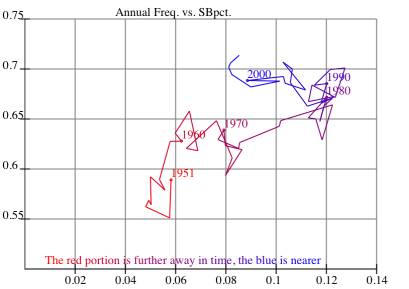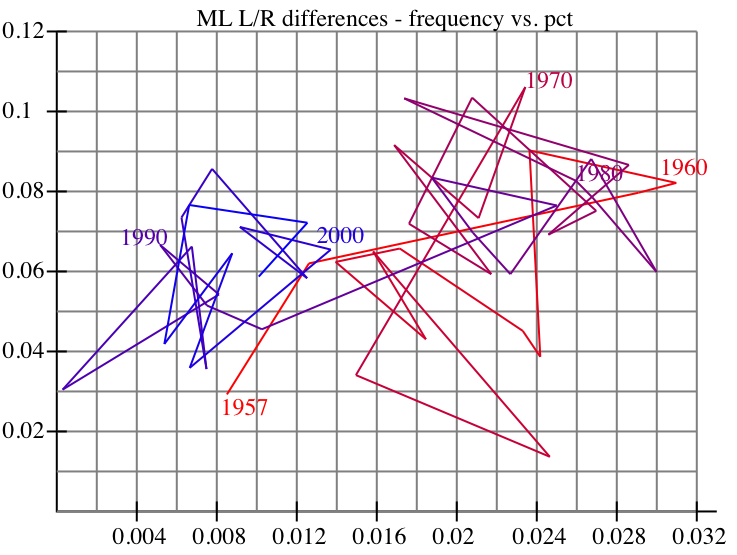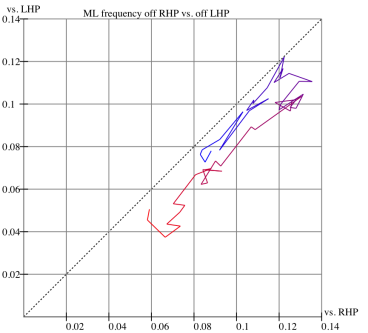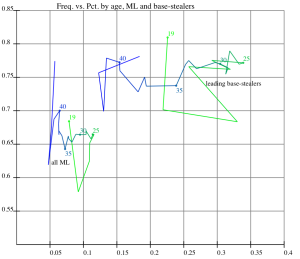
| Designated Hitter | May 17, 2007 |
In a recent broadcast, Joe Morgan mentioned that a base-runner who is able to read the pitcher can find it easier to steal off a left-handed pitcher because lefties are slower to the plate then righties.
If this is so, then it ought to show up in the results. To start, I went to retrosheet.org to look at some splits. What were Joe Morgan's totals? He is listed as stealing 520 bases in 645 attempts vs. RHP (80.6%); and 167 out of 204 vs. LHP (81.9%). Next, I estimated the number of opportunities as singles plus walks - certainly not a perfect measure, as pitching changes sometimes occur (I suspect that this is a small effect) and often 2b is occupied (perhaps a larger effect, though it ought not differ by more than a few percent between LHP and RHP), but it should offer a decent approximation.
Pro-rating per estimated opportunity (Eopps), Morgan's totals were:
vs RHP: .213 SB and .051 CS vs LHP: .149 SB and .033 CS
If Morgan found lefties easier to steal on, it seems odd that he'd steal only 2/3 as frequently against LHP. His success rate suggests that he might have been able to read LHP well enough to only go when he had a good chance of success, but the fact that he ran less often is in conflict with a general "easier to steal" claim.
Let's start by trying to set some context. What patterns do base-stealers have? I'll look at the frequency (attempts divided by estimated opportunities) and stolen-base percentages for all players. The graph shows the frequency of attempts vs. the success rate starting in 1951, the first year that both leagues counted caught stealing (CS). (Data from baseball databank)
For example, in 1951, the SB frequency was .0582, and the SB pct. was .589; in 1952, the frequency was .0576 (nearly the same), but the SB pct. dropped to .551, causing the path plotted to plummet nearly straight down. The SB pct. then increased fairly steadily through the 1950s, reaching a new equilibirum in the .60-.66 range. At that point, the frequency began to rise rapidly as Luis Aparicio and Maury Wills experienced success, moving the path to the right. With Lou Brock's record-breaking performance in 1974, the frequency rose beyond .100, and the greater emphasis on the cerebral aspects popularized by folks like Brock and Morgan led to a new rise in the SB pct., which passed .667 for the first time in 1980. By this time, Tim Raines and Rickey Henderson were entering the picture, and steal attempts reached a new equilibrium in the .112-.127 range, while SB pct. gradually improved from .65-.67 in 1975-84 to .67-.70 in 1985-1994. As the new offense-friendly parks entered the league and the home run explosion started, the frequency began to drop, while success rates continued to rise, reaching .700 in 1995. In six of the last seven years, the frequency of steal attempts has been in the .081-.090 range, while SB pct. has risen each of the last four seasons (from .682 in 2002 to .694, .702, .706, and .714), making it appear that we are in the middle of a new transition.
|
 |
Plotting the SB vs. left / SB vs. right paths on the same graph produces a tangled web. So instead, let's look at the differences, R - L, for both frequency and success rate. This is still rather tangled, but it does seem to show that the difference between LHP and RHP has diminished in recent years. In 1962, the RHP frequency was .073, the LHP frequency .049, making a difference of .024 in the frequencies. Despite stealing less often against LHP, the difference in SB pct. against LHP (.618) and RHP (.657) was one of the lower totals of that era. The difference in frequencies stayed in the .020-.030 range until the late '80s, when the frequency of attempts vs. LHP began to rise, topping out in 1992 at .1224 vs. RHP and .1221 vs. LHP, a difference in frequency of only .0003, the left most point plotted on the freq. vs. pct. graph below. The frequency differences seemed to have stabilized around .010, much lower than the differences seen 20-30 years ago. During this time, the difference in SB pct. appears to have decreased as well. Thirty years ago, differences like those of 1977 were typical, the SB pct. vs. RHP was .647, vs.LHP it was .578, a difference of .069. SB pct. differences were generally in the .060-.080 range then. But in the last twenty or so years, the difference in SB pct. has been in the .040-.080 range, with the 2006 difference of .058 (.728 vs. RHP and .760 vs. LHP) representing a typical difference in success rates. Overall, success rates have increased in the last 50 years, but sucess rates against LHP have increased even more than success rates against RHP. The LHP advantage in holding base runners appears to have decreased, runners are stealing against them at frequencies and success rates that are closer to those of RHP than they were a generation ago.
 |
|
As base-stealing became more frequent, the increase against RHP was greater than the increase against LHP, then the RHP frequency leveled off. Both have receded in recent years. |
 |
A related question pops up regarding the interplay between experience and aging. As players get more experience, many presumably learn ways to improve their success rate, but they also slow down. So next, we'll take a look at the Freq/Pct graph based on the players' age as of July 1.
Young players steal more frequently, through age 25, and then gradually taper off. The sucess rates are pretty consistent, except for a drop during the initial increase in frequency, and a rise during the rare steals by older players. It's not clear to me whether this is due to player experience, or a bias in created by removing the lesser players.
 |
| The younger (greener) players are represented by green, the older by blue. |
Do these same trends hold for the leading base-stealers? To consider this, I took a look at the players who stole at least 300 bases in the retrosheet years (1957-1998, 2000-2006). There were 26 of these. A look at their aging patterns shows that it is similar to those of the general base-runner, except that the base-stealers stayed near their peak rate for several more years than the average player. As the base-stealers aged, their relative frequency of attempts versus LHP seems to increase, but their success rate drops. This makes it unlikely that more experienced base-stealers are picking up extra cues against LHP.
 |

|
Here are the rates for the 26 base stealers, their average, and the overall major league average for 1957-98, 2000-06.
| Name | R Freq | R Pct. | L Freq | L Pct. | Freq. ratio L/R |
| Alomar | .207 | .813 | .173 | .763 | 0.84 |
| Aparicio | .240 | .790 | .208 | .751 | 0.87 |
| BarBonds | .168 | .796 | .170 | .745 | 1.01 |
| BobBonds | .323 | .752 | .237 | .659 | 0.73 |
| Brock | .413 | .767 | .416 | .721 | 1.01 |
| Butler | .286 | .718 | .230 | .599 | 0.80 |
| Campaneris | .340 | .776 | .380 | .748 | 1.12 |
| Cedeno | .382 | .765 | .291 | .724 | 0.76 |
| Coleman | .544 | .801 | .652 | .826 | 1.20 |
| DeShields | .335 | .780 | .312 | .725 | 0.93 |
| Grissom | .254 | .806 | .278 | .744 | 1.10 |
| Harper | .286 | .771 | .252 | .793 | 0.88 |
| Henderson | .405 | .835 | .399 | .755 | 0.98 |
| LeFlore | .477 | .796 | .370 | .682 | 0.77 |
| Lofton | .319 | .799 | .248 | .787 | 0.78 |
| Lopes | .367 | .851 | .230 | .753 | 0.63 |
| Molitor | .170 | .813 | .215 | .756 | 1.26 |
| Moreno | .495 | .747 | .499 | .672 | 1.01 |
| Morgan | .264 | .806 | .182 | .819 | 0.69 |
| Nixon | .445 | .790 | .447 | .718 | 1.00 |
| Raines | .327 | .879 | .230 | .738 | 0.70 |
| Sax | .300 | .728 | .274 | .678 | 0.91 |
| OSmith | .250 | .813 | .218 | .756 | 0.87 |
| Wills | .320 | .740 | .357 | .732 | 1.11 |
| Wilson | .425 | .853 | .251 | .760 | 0.59 |
| Young | .322 | .764 | .298 | .667 | 0.92 |
| Avg. | .317 | .794 | .287 | .737 | 0.90 |
| ML Avg. | .103 | .682 | .088 | .617 | 0.85 |
Most of the leading base-stealers stole more frequently and more successfully against RHP. But several ran more often against LHP, and Joe Morgan, Tommy Harper and Vince Coleman had a higher SB pct. against LHP. The leading stealers relative frequency of attempts was a little higher, 90% as frequently as against RHP, while the general population attempted steals only 85% as often against LHP, but the difference in success rates was nearly identical, 6.7% vs. 6.5%. This is consistent with LHP being tougher to run on in general. But are there LHP who are easier to run on than RHP?

To look at base-stealing from the "who's pitching?" perspective, I went through the Retrosheet team rosters, which conveniently include pitchers' SB/CS/PO data in the fielding data (for example, for the 1975 Red Sox). Breaking these into left- and right-handed pitchers gave the following totals:
Hand Est.Opps SB CS Pickoff Freq. SB Pct. RHP 1284662 89828 41938 6437 .1026 .682 LHP 533131 28812 17894 6151 .0876 .617
Other than a slight increase in Freq. and SB pct. for pitchers near 40, the aging patterns graphs were pretty flat.
Next, I considered pitchers with at least 1000 estimated opportunities. There were 400 RHP and 177 LHP. These RHP saw stolen-bases attempted at a rate of .1037, while the LHP were at .0884, rates nearly identical to those of all pitchers. The SB pct. were slightly lower against these pitchers, .660 vs. RHP and .592 vs. LHP. Are there left-handed pitchers that are among the easiest pitchers to steal on? The answer... very few. The graph here shows these 577 pitchers, plotting frequency vs. SB pct. The extremes are represented by Dwight Gooden whose frequency was .205 and SB pct. was .780. The highest SB pct. was against Mark Clear at .872, with runners going at a frequency of .174. The least-run-on pitcher was Whitey Ford, with a frequency of .025, one steal attempt for every 40 estimated opportunities, and a SB pct. of .385. The lowest opponents SB pct. was turned in by Billy Pierce at .341. Pierce's frequency was also low, at .031. Most of the hard-to-steal-on pitchers are left-handed, most of the easy-to-steal-on pitchers are right-handed.

What about Morgan's statement that LHP are slower to the plate? If so, perhaps most base-stealers aren't reading the pitcher well enough to take advantage of the slower delivery. Until Retrovideo comes along, we won't be able to answer this definitively, but now that several World Series broadcasts are available on DVD, maybe we can start to study the question directly. Conveniently enough, one of the DVDs available is the 1975 World Series. Watching the Series, I discovered that the broadcasters said that Morgan claimed to be able to read the Red Sox pitchers, and that he wouldn't get caught stealing again - he wasn't. During game seven, the claim was made that Morgan had picked up something in Bill Lee's delivery and had passed the information on to Dave Concepcion and Ken Griffey. But when they got to first, there were three pitches on which they were heading back to first when the pitch was delivered - not exactly a great jump to get. On the other hand, when Morgan stole second during the game, he started for second base less than a tenth of a second after Lee began his delivery home, allowing Morgan to steal second standing up. That's a very quick jump. There's the anecdotal evidence. How long do the pitchers take to deliver the pitch? I looked at all games in the 1975 World Series, and portions of games 5 and 6 in the 1986 World Series.
To measure the time to the plate, I took the time from when the pitcher first started stepping toward home until the time the pitcher released the ball. I timed pitchers who were working from the stretch and found that most take about the same amount of time in the stretch whether or not there is a runner on first with second open. Without doing a detailed study, I found only two exceptions in the few games that I looked at: Firstly, with Joe Morgan on first with second base open, Luis Tiant knocked nearly a quarter of a second off his delivery time. Secondly, in the 1986 World Series, Roger Clemens dropped about a tenth of a second off his delivery time with a runner on first and second open, relative to his other pitches from the stretch.
The graph below shows the delivery times that I recorded for pitchers pitching from the stretch in the 1975 World Series and the 1986 World Series (games 5 and 6). Again, pitchers who throw with their right wing are in the red state, and those who throw with their left wing are in the blue state. The bars represent two standard deviations on the estimation of the mean time.

The average of the mean delivery times for the 18 RHP was 1.10 seconds, for the 9 LHP, 1.21 seconds. Some of the extremes here are notable. Dwight Gooden has the highest attempt frequency during the past 50 years as well as the season with the most opponents stolen bases, 60 in 1990. The second highest single season total is 56 by Gooden in 1988 and Floyd Youmans in 1986. Sid Fernandez was the easiest LHP to run on in the last 50 years, with both the highest frequency of attempts and highest SB pct. among all LHP with at least 1000 estimated opportunities. Don Gullett is tied for the second lowest opponent SB pct (at least 1000 estimated opps) behind Billy Pierce's .341 (for 1957-1964). Gullett and Kirk Rueter were at .345. (Rueter's 1999 data is not available.) Gullett's delivery times may be related to his low steal rate. More study is needed. Out of curiousity, I checked to see how a young Joe Morgan ran against a young Don Gullett. Morgan was on first base three times with second open, and did not attempt to steal.
In summary, what did I find?
- Left-handed pitchers are more difficult to steal on.
- Some base-stealers appear to have been able to steal as well or better against LHP than against RHP.
- LHP appear to take more time to pitch from the stretch than RHP
John Rickert teaches mathematics at the Rose-Hulman Institute of Technology, and joined the Society for American Baseball Research in 1983 after reading John Davenport's Baseball Graphics and Bill James' Baseball Abstracts.
Comments
The key is IF the runner can read the pitcher. I take from this data that lefties can be harder to read. This makes sense because unlike right handed pitchers, when the front foot leaves the ground and the back foot remains on the rubber he can still come to first. I don't think Morgan's statement and your research are in conflict.
Posted by: orangeandblueblood at May 17, 2007 4:51 AM
Interesting study, but Joe Morgan will never believe all this stuff if he finds out you used computers to figure it out.
Posted by: Bird at May 17, 2007 8:22 AM
What graphing utility did you use to plot figures 1-6?
Posted by: Dan at May 17, 2007 11:55 AM
You have to include pickoffs when analyzing lefties and include that as a CS! If you don't all of the numbers versus LHP are misleading. As well, you have to include balks and consider that as a succesfull steal.
Posted by: MGL at May 17, 2007 1:47 PM
I would imagine the biggest reason for the differenial in the time it takes lefties to deliver the ball is the fact that they dont have to commit to deliver the ball to the plate the moment they start their delivery. Andy Pettite is a perfect example. He delays committing to the plate for as long as possible. That is why he is one of the best at pick-offs.
Posted by: vttex at May 17, 2007 2:00 PM
Dan: A long time ago, a friend of mine convinced me that it would be useful to learn how to write postscript. So I had the analysis program output the approriate postscript code to a file, then converted the .ps to .png
MGL: You're right. My excuse is that I didn't have those data for the baserunners, so to make the numbers directly comparable, I used just SB/CS. A more complete study using the play-by-play should include the pickoffs and balks, and probably compile wild pitches, passed balls, throwing errors, and extra bases advanced on singles and doubles (ideally, broken down by location of the hit).
vttex: That doesn't explain the difference in time for non-steal stretch situtations. I suppose this could be checked by analyzing the motion in more detail. I didn't notice a significant difference in the structure of the stretch in steal vs. non-steal situtations, but I didn't look for it either. I guess I'll need to get those Yankess World Series DVDs sooner. I do notice that after leading the league in pick-offs his first 3 years, Pettitte's pick-offs plummeted precipitously, his last year with the Yankees showed 13SB, 1CS, 0 pick-offs. But he's still 8th among all pitchers with at least 1000 estimated opportunites, and first among those with 2000 opps.
Posted by: jrickert at May 17, 2007 5:55 PM
The bottom line is that it depends on what you mean by "easier to steal."
Versus a righty, you take off as soon as the pitcher so much as budges his left leg. Then it is a race between the speed of the pitcher to release the ball and the speed of the catcher to catch it and get it to second.
Against a lefty pitcher, the dynamic is completely different. If you wait until the pitcher lifts his leg and you determine that he is going home, you will generally be nailed. If you go on "first movement" AND THE PITCHER ENDS UP GOING HOME because you either somehow knew that or you just took a guess, you will usually be safe because a lefty pitcher is indeed slower than a righty on the average.
The problem is that runners get picked off and caught stealing all the time when they go on first contact. Either they are wrong in thinking that they knew that the pitcher was going home or they took a shot and it didn't work out. Either way, the number of caught stealings plus pickoffs compared to SB and balks is substantially higher against lefty pitchers than against righty pitchers. If I were in charge of a team, I would simply tell my baserunners never to steal versus a lefty. I would also tell them that that means never to get picked off either (IOW, pay attention and watch your lead).
So, when you say, "It is easier to steal against a lefty," which many (if not most) broadcasters besides Joe Morgan say, that statement must be qualified. It means that if you "guess" right, you will be safe almost all the time. But overall, you (all runners combined) will in fact fare WORSE against a lefty pitcher than a righty. Whether that means that lefties are "harder to run against" is a matter of semantics.
Again, while the crux of the analysis in the article is great, without the CS and the PO (and the errors on throws over to first), the results of ANY analysis are meaningless, regardless of the reason why the author did not include them. Technically to do any SB analysis, you also have to include what happens on a batted ball when the runner is attempting a steal and also what happens with the pitcher/batter matchup when a potential basestealer is on first. Existing research has suggested that the net effect of a basetealer on the batter/pitcher matchup is about a wash (no net effect) because the batter probably gets more fastballs/strikes, he takes some pitches that he would ordinarily not take, the pitcher and defense may get distracted, and the batter may get distracted or otherwise be out of his usual "rhythm."
One fascinating thing that we found in the research for The Book was that there appeared to be a huge difference in the effect of a basestealer on the batter/pitcher matchup depending upon the age/experience of the batter, suggesting that older more experienced batters kmow how to maximize (or perhaps minimize the distraction) that effect while the younger players are doing SOMETHING that adversely affects their performance (such as taking too many pitches or letting themselves get distracted or losing their focus).
Posted by: MGL at May 17, 2007 6:25 PM
Maybe a follow-up conversation w/ Mr. Morgan is in order. He might have learned to read/steal off of lefties as his career progressed, which became more important as his speed declined. The numbers over the last five years or so of his career might be revealing?
Posted by: BWJ at May 18, 2007 9:31 AM